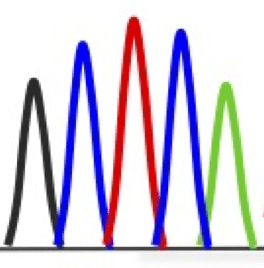Copper toxicosis, COMMD1-related
Gene: COMMD1
Transmission: Autosomal, recessive
For an autosomal recessive genetic disease an animal must have two copies of the mutation in question to be at risk of developing the disease. Both parents of an affected animal must be carriers of at least one copy of the mutation. Animals that have only one copy of the mutation are not at risk of developing the disease but are carrier animals that can pass the mutation on to future generations.
Mutation: Deletion, COMMD1 gene: Deletion of 39.7kb in introns 1-2 and 2-3, removing exon2, chromosome10
Breed: Bedlington Terrier
Medical system: Digestive
Age of onset of symptoms: From the age of 1 year for the detection of copper accumulation in the liver; 3-4 years for the appearance of clinical signs of the disease.
Copper is an essential trace element that is required in several key metabolic body processes. Copper excess and accumulation in the body leads to copper toxicosis which can have both genetic and environmental causes. The genetic disease, seen in both humans and the dog, has historically been called Wilson disease, and can involve deregulated copper uptake, utilization and/or excretion by the body.
In the 1970s and 80s, copper toxicosis was reported as a genetic disease with autosomal recessive heredity in the Bedlington Terrier dog breed. In susceptible but as yet asymptomatic animals, copper accumulation was detected in the liver by one year of age. By 3-4 years of age, clinical signs of copper toxicity include lethargy, anorexia, vomiting, polydipsia (increased drinking) and polyuria (increased urinary frequency), progressing to overt signs of hepatitis and cirrhosis including jaundice, weight loss, abdominal fluid retention (ascites), and hepatic encephalopathy (deterioration of brain function). On lab analysis, affected animals show increased copper accumulation in the liver and decreased copper excretion in the bile. DNA studies in 1999 identified a linked marker on chromosome 10 while in 2005 the causal mutation for the disease in Bedlington terriers was identified in the COMMD1 gene. This gene codes for a protein involved in normal cellular protein degradation and its inactivation results in disrupted copper excretion in the bile leading to the progressive accumulation of copper in the liver and the clinical signs of copper toxicosis. DNA tests for the COMMD1 mutation have reduced but not eliminated copper toxicosis in Bedlington Terriers, indicating that mutations in other genes must also be involved in the disease. In 2016, studies in the Labrador retriever identified mutations in the ATP7B gene, which codes for a copper transport protein in the cell membrane, as an additional potential cause of copper toxicosis. This mutation was subsequently shown to contribute to the disease in Bedlington Terriers. In addition, environmental factors, such as copper content within the diet, can affect the presentation and progression of the disease.
Copper toxicosis in the dog remains a polygenic disease with environmental contributions. DNA tests are advised for animals in susceptible breeds that are to be used for reproduction. Diets with reduced copper content and medication to increase copper excretion are available to treat affected animals.
See also:
ATP7B gene, Labrador Retriever. OMIA link [1071-9615]
References:
OMIA link: [1988-9615]
Mutton J, Yeomans S, White J. (2024) Copper hepatopathies in Australian dogs. Aust Vet J 102:385-391. [pm/38682427]
Haywood S, Swinburne J, Schofield E, et al. (2023) Copper toxicosis in Bedlington terriers is associated with multiple independent genetic variants. Vet Rec 193:e2832. [pm/37038639]
Haywood, S. (2006) Copper toxicosis in Bedlington terriers. Vet Rec 159:687. [pm/17099181]
Forman OP, Boursnell ME, Dunmore BJ, et al. (2005) Characterization of the COMMD1 (MURR1) mutation causing copper toxicosis in Bedlington terriers. Anim Genet 36:497-501. [pm/16293123]
Johnson GF, Sternlieb I, Twedt, DC, et al. (1980) Inheritance of copper toxicosis in Bedlington Terriers Am J Vet Res 41:1865-6. [pm/7212417]
Contributed by: Stéphanie Belhumeur and Aziliz Duverger, Class of 2029, Faculté de médecine vétérinaire, Université de Montréal. (Translation DWS)

